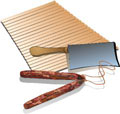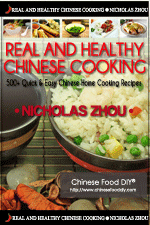



   
 


|

|
Home
>
Cooking Tips
>
Before You Buy a
Chinese Cleaver
Before You Buy a
Chinese Cleaver
|

Chinese Cleaver
|

|
|
|
|
For an
all-purpose cutting utensil, nothing beats a
Chinese cleaver. Every part of the knife is put
to use. The sharp edge of the blade is used for
cutting, while the blunter top edge is used to
pound and tenderize meat. Turned on its side,
the cleaver is an excellent tool for smashing
garlic and
ginger. You can even use it to
transfer food from cutting board to wok. An
added bonus is that the flat end of the handle
nicely substitutes for a pestle.
 It's All in the Blade It's All in the Blade
Traditionally, cleavers blades were made of
carbon steel. The problem is that carbon steel
is highly susceptible to rust. Also, they tend
to add a metallic taste to the food. Today,
even well known cookbook authors such as Martin Yan and Eileen Yin-Fei Lo recommend blades that
are stainless steel, or a combination of carbon
and stainless steel.
 Cleaver or Knife? Cleaver or Knife?
Just because a Chinese cleaver looks like a
western butcher's cleaver doesn't mean you can
use it to chop bones. Heavier cleavers are
designed for this. However, the primary
function of lighter cleavers - often called a
Chinese Chef's Knife - is slicing meat and
vegetables. Chopping bones with these lighter
cleavers can ruin the blade. If you're
uncertain which type of cleaver you have, check
with the store where you purchased it.
 Choosing a Cleaver Choosing a Cleaver
Ask two experts to
name their favorite cleaver and you will get two
different answers. Like ice cream flavors,
choosing a cleaver is a very personal decision.
The most important thing is to find one that is
well made. Dexter, Martin Yan and J.A. Henckels
are all good brand names.
Your comfort level is also important. The
cleaver should feel solid, but not too heavy. If
your arms feel strained when holding the
cleaver, try another. Preparing dinner shouldn't
be hard work!
Buy Cleavers Online
(Recommended brands by Nicholas Zhou)
 Sharpening a Cleaver Sharpening a Cleaver
A cleaver
blade should be sharpened regularly. A dull
knife forces you to exert more pressure, which
can lead to unpleasant accidents.
There are several ways to sharpen a
cleaver. One of my cooking teachers swears by a
smooth piece of sandstone she picked up during
an afternoon stroll nearly twenty years ago.
However, a more popular option is to use a sharpening steel. Sharpening steels
don't actually remove metal - instead they
realign the blade edge at a molecular level.
 Care and Maintenance Care and Maintenance
The
important thing to keep in mind when it comes to
cleaning and storing the cleaver is protecting
the blade. Cleavers should be stored in a
proper knife block where there is less risk of
damage. As for cleaning, for best results wash
the cleaver by hand in warm, soapy water. Dry
thoroughly - even stainless steel isn't
completely rustproof. And be sure to clean the
blade immediately after working with acidic
ingredients such as tomatoes.
 |
Get ready to
cook Chinese food?
Click here to see
500+ Real and Healthy Chinese Food Recipes
in 5 minutes! Plus 200+ cooking
tips and 170+ colorful pictures.
|
"500+ Healthy Chinese Recipes in 5 minutes"
|

|
Nicholas Zhou's
cookbook "Real & Healthy Chinese Cooking" -
500+ low carb and low fat recipes with 170+ colorful pictures.
Based on a master chef's 40 years of cooking practice and 4 years of writing
and research, it has helped over 12,800 people worldwide improve
their health. All the secret copy cat recipes in ONE cookbook.
Click here to read the whole story that reveals how
ANYONE can cook delicious Chinese food and improve their health... in less than 20
minutes. | |
Related
Links:
Chinese Cooking Tips

|
|
|
|
|
|
|

|
|

|
|
